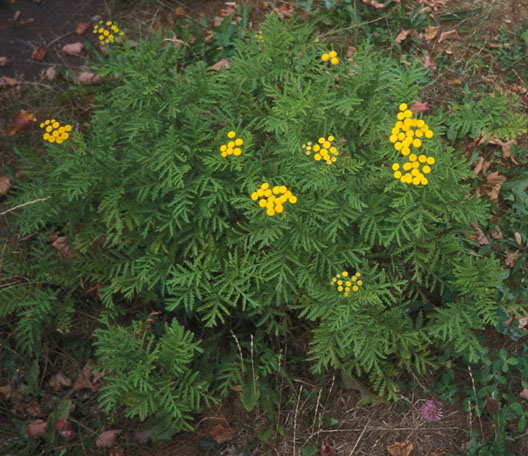
|
| Tansy; Tanacetum vulgare L. |
| = Chrysanthemum vulgare (L.) Bernh. |
Sunflower Family; COMPOSITÆ (ASTERACEÆ)
|
| Tansy is famous in European herbal traditions, and common enough wild here that you should get to know it. Fortunately,
gardeners are not pestered by it, but everyone who notices sunny waste areas, roadsides, and fields can easily come to recognize it. |
| There is only one problem: local publicity about Tansy Ragwort
(Senecio Jacobæa) has rendered that plant infamous, and caused confusion with the original Tansy. True, both species are robust weeds whose bright yellow flowers make waist-high displays
of yellow in late summer. But they are no more identical than cheese and "cheese product." So, Tansy itself gets the spotlight this
month. Tansy Ragwort deserves some future month. |
| As you can see, Tansy's flowers are clustered atop stems. In fact they are
densely clustered: more so than most artists are willing to depict. They open rich yellow and gradually fade dull brown while transforming from fragrant insect-attractants to seedheads.
June through October is their season. Imagine daisy blossoms bereft of their white petals and you'll apprehend the idea behind
Tansy's flower structure. When seen in the freshness of their full bloom, their beauty is real, but evanescent. More enduring visually is
Tansy's distinctive habit of forming strongly upright clumps of fernlike foliage topped by the button-like flowers. Gardeners occasionally
grow Tansy in its crispy-leaved version for foliar effect as well as floral warmth. Weedy it can be, thus, but not ugly, nor useless. |
| To me, odor and chemistry rather than appearance are Tansy's strong points. Of commonly seen weedy wayside plants, few
have as many medicinal properties ascribed in herbal medical literature. The major attributes follow (to list
all would simply amaze you and discredit me): anthelmintic, antiseptic, aromatic, cordial, diaphoretic, emmenagogue, febrifuge, irritant narcotic, stimulant,
stomachic, sudorific, tonic, vermifuge, vulnerary. Not to mention being an ant-repellant and acne cure. In other words, Tansy is drug-like,
and people must be wary of ingesting it. |
| Its hot flavor alone is reason enough to be reserved with it. People who have eaten Tansy have generally done so sparingly,
and justified the action as a stimulating jolt to add home-run flavor to otherwise boringly flavored foods. I used to eat it, but stopped
after learning that it has caused deaths, and hurt people even when used externally. At any rate, you should at least be brave enough
to stroke its ferny foliage and squish the leaves in order to smell their exhilarating potency. Taste the plant, too, just for shock effect.
Do it. What better way to appreciate this powerful plant of historic repute? Revere its properties; just don't experiment carelessly
with such a fiery thing. |
| It grows in sunny waste places, and is rarely a regular garden pest. The normal height at bloom-time is 2 to 4 feet, but in
rich conditions 6 feet is attainable. Too much shade or moisture causes it to grow lank, become mildewy, and even quit living. No soil
is too wretched for it. A perennial, it lives forever, although frost browns it to the ground each winter. |
| Other names for Tansy are few, and usually are read rather than heard: Golden Buttons, Bitter Buttons, and, both quaint
and ancient, Joynson's Remedy Cheese. What a wonderful old name. The derivation of "Tansy" and
Tanacetum is unknown to me, but the plant does have two symbolic meanings in the Language of Flowers (neither at all appropriate in this month of Valentine's Day):
"I declare against you," and "Resistance." |
Plant it in your garden and you may admire it, find it a good companion, and you might, if dyeing is your pleasure, find that
it's true that Tansy roots yield a good green color.
|
Originally published as the Seattle Tilth newsletter Weed of the Month in February 1993, along with an illustration from a book.
Back |
|
|

